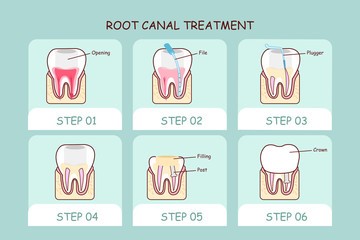
20 May How To Permanently Kill The Nerve Of The Tooth?
Maintaining good oral hygiene is very important. Regular check-ups always help the patient to prevent or perhaps help detect dental issues at the early stage. When patients do not treat minor cavities, or rather neglect them till they experience pain then most often that tooth needs to undergo a Root canal treatment.
Root Canal Treatment is a procedure wherein an endodontist or a skilled general dentist permanently kills the nerve of the tooth. In other words, the soft portion of the tooth which is under the hard structure is completely removed. The soft portion called the pulp is the nerve of the tooth which supplies blood and other nutrition to the tooth.
The root canal procedure is carried out by an endodontist or a general dentist that is highly skilled and experienced.
What are the signs and symptoms due to the involvement of the nerve?
- Pain of chewing
- Intermittent pain
- Pain on having hot or cold items
- Pain on having sweet food items
- Pain on percussion (i.e. Tapping on the tooth with an instrument)
- Nocturnal pain
- Crack in tooth
- Pain due to trauma
The points mentioned above indicate that the tooth needs a root canal treatment However, it is mandatory to take an x-ray before confirming the same.
The X-ray will exactly show how deep the cavity is. It also shows how much of the nerve is infected. If there is any crack in the tooth, the X-ray will help to identify its location as well.

How to kill the nerve quickly?
The procedure to kill a nerve quickly is called a root canal treatment
for the root canal treatment, the following steps are to be carried out:
Day 1: Inject Local anesthesia and excavate the Pulpal tissue
For vital teeth that is, when the tooth is not dead, the practicing dentist will inject the area with some local anesthesia. This is done so that the patient experiences no pain during the procedure and the entire process can be as painless as possible.
Once the patient is well anesthetized, the treating dentist will locate the access to the pulp and start cleaning the pulpal area with the help of the root canal cleaning instruments and the entire chamber and canals are free of the pulpal tissue. The entire area is cleaned with the help of dental disinfectant solutions that are biocompatible and prevents the tooth from getting infected further in the future.
In some cases when the infection is too much, the patient is prescribed antibiotics and painkillers to curb the infection and pain if there is any.
Day 2: Filling and sealing the canals
On the second visit, the treating dentist will clean the empty spaces and debride them with disinfectants once again to make sure they are sterile. After this, the dentist will use filling materials such as gutta-percha to fill in the canals and seal them as well with the help of root canal sealers. Once this is done the coronal area of the tooth is filled with permanent filling material such as composites or glass ionomer cement (GIC)
Day 3: After the completion of the entire process
The patient is kept under observation. During follow-up visits, the treating dentist can keep a check on the infection if it is cleared or not. Most of the time, the infection does not return and the patients are advised to go ahead with the capping process. As per the patient’s choice, the dentist provides various crown/capping options.
Conclusion
Root canal treatments are done in an attempt to save the tooth. However, in some cases the damage is so much sometimes, multiple sittings may be required. Such a situation arises, it is always advisable for the patient to visit an endodontist who is an expert in Root canal treatments.
Patient comfort is very important. Patients visit dental clinics with a fear of pain that has been instilled in them since childhood. In order to avoid this and change their perspective toward dental treatment and advancing technology has allowed the invention of painless dentistry. With new and improved equipment and armamentarium, dentistry these days is becoming less painful and the treatments are also getting completed in a smaller number of visits.
Thanks to the advancements, root canals can also be treated in a single sitting, however, it depends also on the extent of the infection. That is why it is important for patients to go for regular check-ups and treat the issue before it turns into a grave issue.



